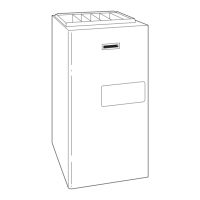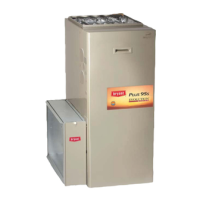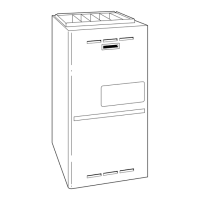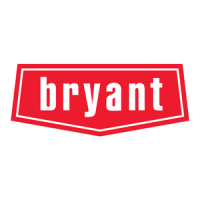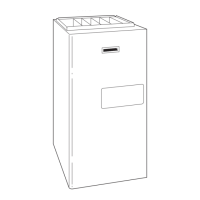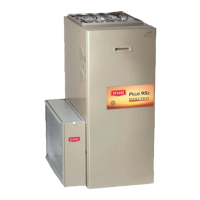39
lows:
Low--heat
--30 seconds after the gas valve GV--M is opened,
the BLWM is turned ON at low--heat airflow.
High--heat
--35 seconds after gas valve GV--M is opened, the
BLWM is turned ON at high--heat airflow.
Simultaneously, the humidifier terminal HUM and electron-
ic air cleaner terminal EAC--1 are energized and remain en-
ergized throughout the heating cycle.
7. Switching From Low-- To High-- Heat-- If the furnace
control CPU switches from low--heat to high--heat, the fur-
nace control CPU will de--energize the the high--heat pres-
sure switch relay HPSR to close the NC contact and slowly
increase the inducer motor speed until the high--heat pres-
sure switch HPS closes. When the high--heat pressure
switch HPS closes, the high--heat gas valve solenoid GV--
HI is energized and the inducer motor RPM is noted by the
furnace control CPU. The RPM is used to evaluate vent sys-
tem resistance. This evaluation is then used to determine the
required RPM necessary to operate the inducer motor in
high--heat mode. The blower motor BLWM will transition
to high--heat airflow five seconds after the furnace control
CPU switches from low--heat to high--heat.
8. Switching From High-- To Low-- Heat--The furnace con-
trol CPU will not switch from high--heat to low--heat while
the thermostat R--to--W circuit is closed when using a
single--stage thermostat.
9. Blower--Off delay-- When the thermostat is satisfied, the R
to W circuit is opened, de--energizing the gas valve GV--M,
stopping gas flow to the burners, and de--energizing the hu-
midifier terminal HUM. The inducer motor IDM will re-
main energized for a 15--second post--purge period. The
blower motor BLWM and air cleaner terminal EAC--1 will
remain energized at low--heat airflow or transition to low--
heat airflow for 90, 120, 150, or 180 seconds (depending on
selection at blower--OFF delay switches). The furnace con-
trol CPU is factory--set for a 120--second blower--OFF
delay.
TWO--STAGE THERMOSTAT AND TWO--STAGE
HEA
TING
See Fig. 49 for thermostat connections.
NOTE: In this mode, the low--heat only switch SW1--2 must be
ON to select the low--heat only operation mode in response to
closing the thermostat R--to--W1 circuit. Closing the thermostat
R--to--W1--and--W2 circuits always causes high--heat operation,
regardless of the setting of the low--heat--only switch.
The wall thermostat “calls for heat,” closing the R toW1 circuit for
low--heat or closing the R to W1--and--W2 circuits for high--heat.
The furnace control performs a self--check and verifies the low heat
and high--heat pressure switch contacts LPS and HPS are open.
The start--up and shutdown functions and delays described in item
1. above apply to 2--stage heating mode as well, except for
switching from low-- to high--heat and vice versa.
1. Switching From Low-- To High-- Heat--If the thermostat R
to W1 circuit is closed and the R to W2 circuit closes, the
furnace control CPU will de--energize the high--heat pres-
sure switch relay HPSR to close the NC contact and slowly
increase the inducer motor speed until the high--heat pres-
sure switch HPS closes. When the high--heat pressure
switch closes, the high--heat gas valve solenoid GV--HI is
energized and the inducer motor RPM is noted by the fur-
nace control CPU. The RPM is used to evaluate vent system
resistance. This evaluation is then used to determine the re-
quired RPM necessary to operate the inducer motor in
high--heat mode. The blower motor BLWM will transition
to high--heat airflow five seconds after the R to W2 circuit
closes.
2. Switching From High-- To Low-- Heat-- If the thermostat
R to W2 circuit opens, and the R to W1 circuit remains
closed, the furnace control CPU will energize the high--heat
pressure switch relay HPSR to open the NC contact and
slowly decrease the inducer motor speed to the required
low--heat RPM. When the high--heat pressure switch HPS
opens, the high--heat gas valve solenoid GV--HI is de--ener-
gized. When the inducer motor IDM reduces pressure suffi-
ciently, the high--heat pressure switch HPS will open. The
gas valve solenoid GV--M will remain energized as long as
the low--heat pressure switch LPS remains closed. The
blower motor BLWM will transition to low--heat airflow
five seconds after the R to W2 circuit opens.
Cooling Mode
The thermostat “calls for cooling.”
1. Single--Speed Cooling
(See Fig. 19 for thermostat connections.)
The thermostat closes R--to--G--and--Y circuits. The R--to--Y
circuit starts the outdoor unit, and R--to--G--and--Y/Y2 cir-
cuits start the furnace blower motor BLWM on cooling air-
flow. Cooling airflow is based on the A/C selection shown
in Fig. 39.
The electronic air cleaner terminal EAC--1 is energized with
115--v when blower motor BLWM is operating.
When the thermostat is satisfied, the R--to--G--and--Y cir-
cuits are opened. The outdoor unit will stop, and furnace
blower motor BLWM will continue operating at cooling air-
flow for an additional 90 sec. Jumper Y/Y2 to DHUM to
reduce the cooling off--delay to 5 seconds. (See Fig. 33.)
2. Single--Stage Thermostat and Two--Speed Cooling (Ad-
aptive Mode)
(See Fig. 50 for thermostat connections.)
This furnace can operate a two--speed cooling unit with a
single--stage thermostat because the furnace control CPU in-
cludes a programmed adaptive sequence of controlled oper-
ation, which selects low--cooling or high--cooling operation.
This selection is based upon the stored history of the length
of previous cooling period of the single--stage thermostat.
NOTE: The air conditioning relay disable jumper ACRDJ must
be connected to enable the adaptive cooling mode in response to a
call for cooling. (See Fig. 33.) When in place the furnace control
CPU can turn on the air conditioning relay ACR to energize the
Y/Y2 terminal and switch the outdoor unit to high--cooling.
The furnace control CPU can start up the cooling unit in
either low-- or high--cooling. If starting up in low--cooling,
the furnace control CPU determines the low--cooling
on--time (from 0 to 20 minutes) which is permitted before
switching to high--cooling.
If the power is interrupted, the stored history is erased and
the furnace control CPU will select low--cooling for up to
20 minutes and then energize the air conditioning relay
ACR to energize the Y/Y2 terminal and switch the outdoor
unit to high--cooling, as long as the thermostat continues to
call for cooling. Subsequent selection is based on stored
history of the thermostat cycle times.
The wall thermostat “calls for cooling,” closing the R to
G--and--Y circuits. The R to Y1 circuit starts the outdoor
unit on low--cooling speed, and the R to G--and--Y1
circuits starts the furnace blower motor BLWM at
low--cooling airflow which is the true on--board CF
selectionasshowninFig.39.
If the furnace control CPU switches from low--cooling to
high--cooling, the furnace control CPU will energize the air
conditioning relay ACR. When the air conditioning relay
ACR is energized the R to Y1--and--Y2 circuits switch the
outdoor unit to high--cooling speed, and the R to
G--and--Y1--and--Y/Y2 circuits transition the furnace
blower motor BLWM to high cooling airflow.
355BAV
